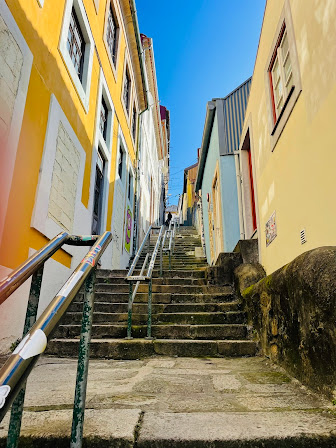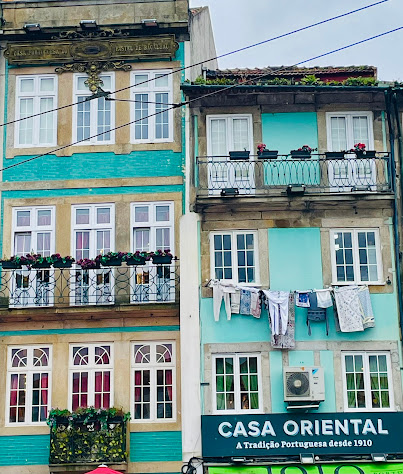We could not tour Castle Pena as planned because a big storm blew through last week and knocked down many of the old trees, blocking our passage. We did walk by other palaces with lemons and oranges growing in the gardens and peacocks strutting about and calling to us from the other side of the gate. As far as i could tell, the peacocks of Sintra do not have that beautiful Portuguese accent everyone else has. We shopped on the historic streets of Sintra for cork, shoes, local jewelry, and sardines. Jim ate his first gelato of the trip. (Chocolate, with a caramel sauce.)
We went off-itinerary to a great little winery hidden away in an old building in Colares, (Adega Regional de Colares) for some wine tasting. They make their wine by the sea and you can catch a hint of sea salt in the undertones. Jim liked the red and I preferred the white. We are so predictable.
We passed Apple Beach, named for the enormous apples which grew nearby. The ocean lay sparkling in the late morning sun, layered in different shades of blue. Next stop, Azenhas do Mar. It was gusty and gorgeous. I probably missed some great ocean views because i was blinded by the all the hair blowing in my face and my sunglasses were forgotten in my car…They are awaiting my return to the long-term parking lot of Newark’s maze of an airport.
Please note the greenish rectangular pool along the shoreline which fills at high tide.
Sometimes riding through these towns, the streets are so tiny we are literally a few inches from passing cars.  Several miles of narrow winding roads followed our visit to the beach with the green pool. Our guide, Sara drove us through Azoia and to Cabo de Roca. Have I mentioned, everyone here drives too fast? It’s like a racetrack for serpentine-loving daredevils. I was thanking heaven for Dramamine and sea bands.
Several miles of narrow winding roads followed our visit to the beach with the green pool. Our guide, Sara drove us through Azoia and to Cabo de Roca. Have I mentioned, everyone here drives too fast? It’s like a racetrack for serpentine-loving daredevils. I was thanking heaven for Dramamine and sea bands.
The seaside town of Cabo de Roca was chilly! There was a lighthouse, many people hiking the coastal hillsides, and breathtaking views. Apparently on Sundays people cannot even park there because the town is overrun with motorbikes. Right down to the yellow seaside flowers, this coastal area felt a lot like Big Sur.
Coffee cups are small here. They’re just a tease for my husband’s caffeine-dependency.
For lunch, we drove to Cascais (pronounced Cash-Kaiz). It is a luxury private community about 30 kilometers (30 minutes) from Lisbon. The most western point of Europe. If we could look across the Atlantic, we’d be right in line with Lady Liberty in New York Harbor. We could see last weekend’s storm damage in Cascais, but it was otherwise very clean. There were shipping vessels off the coast, waiting for approval to dock in the Lisbon harbor. There were fishing boats in the bay, too.
Jim and I had lunch at Jardim dos Frangros where I had Bacalhau a Bras, a traditional codfish dish. We had a soft mild local cheese on bread to start. There was something on the menu called Secretos de Porto Preto (pork secrets…grilled on charcoal). We did not want to know that secret, thank you very much. Obrigadissima.
Our Uber ride back to the hotel was basically an exercise in crawling through the city, rather than driving. So.Much.Traffic. We could have walked faster for 95% of the route. It did, however provide the opportunity tor people watching and appreciating the buildings. Many of the untiled buildings in and around Lisbon are painted in pastel hues, usually in pink, yellow, mint green, or salmon. Occasionally blue.

I wrote some postcards and read for an hour at our hotel while Jim napped and then we were off again, walking up some crazy-hilly streets to an overlook of the city. The sun was beginning to set and evening Lisbon was just getting started. Everyone is out on the streets at night with restaurateurs wooing passersby to their indoor and outdoor tables. They are relentless with promises of fado, glasses of wine, fresh fish, specialty items and one-liners in multiple languages. The competition for hungry tourists is fierce. Once seated, couverts are brought to the table…things like plates of cheese and baskets of bread. If you don’t want to add these items to your meal (and your tab), you have to send them away. Dinner alfresco just down the street from our hotel was delicious. Jim had another tomato-based seafood soup and a bowl of shrimp, swimming in a butter just bobbing with cloves of roasted garlic. I had tuna salad (literally fresh tuna on greens) which was most definitely NOT from a can.
We are four hours ahead of “home time” and it is time for bed tonight as tomorrow we rent a car early and join all the other maddeningly dangerous drivers on roads where we cannot read the traffic signs. What could possibly go wrong?
Portugal: Day Three
After a delicious breakfast in our hotel, we were back in an uber and on our way to the Europcar Rental office across town. My panic and dread were on high alert as the very sweet salesperson (Telma) answered our concerns with, “We don’t know what some of the road signs mean, either….”
She refused to accompany us and serve as translator for seven days of adventure in our grey Leon. (Believe me…I asked.) So instead, we loaded up on the roadside assistance option to accompany the full insurance package…. (My husband winced…but he capitulated and plugged the rising dam of my emotional anxiety with some additional colorful euros.) As Jim says…”it’s just play money.”
Most people can speak some English here. We were told by our Italian friend it is because the movies that are produced in the States air in Portugal in English with Portuguese subtitles. Plausible? Maybe.
Driving in the city was a form of torture. We rounded the initial large traffic circle, going around the statue of Marques de Pombal MORE than once before determining which of the unintelligible street names was being rattled off by the voice of our smug and insistent GPS. There were horns honking and even some wild gesturing from the man in the car behind us…. Once we made it onto the highway, my stress level thankfully dropped like a lead sinker.
We traded our planned itinerary for tomorrow’s agenda and will hit the Sunday plans on Monday. Well, hopefully not HIT. (I don’t want to use that word until we return this European rental car in one piece in a week….)
We went over the 25 April Bridge which was designed by the same company responsible for the Golden Gate Bridge. Towering next to the bridge and overlooking the city of Lisbon is Christ the King monument. This huge edifice was inspired by Brazil’s Christ the Redeemer statue in Rio de Janeiro after a cardinal returned from a trip there and the project began one year before Jim’s birth. I’m sure you’ve seen it. Jesus with his arms outstretched.
While listening to Portuguese car tunes interspersed with French songs, (and Billie Eilish, and Adele), the idyllic scenery rolled by. There were vineyards and several congregations of brown cows, some of which were grazing in historic olive groves, the silvery leaves of the trees catching the morning sun.
(This is not my photo)
A rather large egret or heron flew over the highway, commanding our attention. Soon Jim, (or as our first Uber driver referred to him, “Jam-Iss” -emphasis on the jam) noted there were many enormous nests for seabirds affixed to the high electrical distribution towers alongside the highway.
I looked up these long-legged wonders on Google and the nest-dwellers are apparently the White Storks of the Alentejo and the Algarve. STORKS! None were toting brand new babies for delivery, as far as I could tell.
We found a parking spot outside the Evora city wall, just like Rick Steves suggested in his handy guide to Portugal. When we walked through the opening of the wall, I was immediately charmed. The gardens were to our right and the tiny cobblestone streets were inviting against the once-white buildings with marigold trim. We met a black cat who was peeking from a second floor balcony. I was a little worried Jim’s universal cat-call, “Psssss-pssss-psssss” might inspire the feline to leap down upon us, testing one of its remaining nine lives.
We came upon Praca do Geraldo (the town square) which was the market during the Moorish period. Irresistible pottery was purchased (and securely bubble-wrapped). I’m growing increasingly concerned about the airline weight limit on my suitcase.
Soon there were delightful tones from the bell tower of Se de Evora, summoning us to pay the higher ticket price for full admission (from a guy who looked like Stanley Tucci).







First stop with our cathedral tickets was the tower which ended up being an exhausting climb to the rooftop terrace. The tiny enclosed spiral stone staircase was incredibly claustrophobic and the pressure was seriously ON. Ascending and descending required an actual red light-green light above the doors to prevent an unfortunate and permanent tourist clog, which would surely come to pass if someone unwisely or impatiently tried to pass another human being on that staircase. The traffic system was just fine for the descent, but terribly embarrassing for the poor sod climbing up. One could not really pause mid-ascent. That means the crowd at the top (standing in the queue and all but toe-tapping) was in excellent position to hear the desperate panting (AKA gasping for final breath) of the less-fit tourists emerging into the rooftop sunshine. Positively mortifying.
The rooftop view of the city and surrounding Alentejo plains was mostly worth the effort.
The cloister to follow was built in a sturdy and imposing Portuguese-Romanesque style. I loved spying the beauty of the small garden through the open stone windows.
Our deluxe tickets gained us entry to the “treasures” promised in the Museum of Sacred Art. My favorites included a painting of the Archangel Michael, another painting on wood which must once have been a door as it still boasts a keyhole, and several works depicting the Holy Mother. Some of the vibrant paint colors from the 16th and 17th centuries are remarkably well-preserved. Jim was thoroughly done “appreciating” cathedral artifacts by the time we hit the second floor. He did pause for a split second to note the large glass-encased Nossa Senhora da Boa Morte. (Our Lady of Good Death). I’m guessing our lady perished whilst attempting the climb to the bell tower of the cathedral and they just snapped her into that rectangular glass box to bolster the displays on the second floor of the Museum of Sacred Art.
The 12th Century Evora Cathedral (Gothic and Romanesque style) was next. It was dark, cold, beautiful, and inspiring. It smelled of musty ancient wood rather than the incense I often note when entering a cathedral. I’m always a little disappointed when I can’t pay to light a candle for someone and there were no candles for me today.
On our way to lunch in a garden, we briefly appreciated some Roman ruins where 2,000 years ago, the marble columned square highlighted a grand temple complete with reflecting pools.
We had toasted cheese sandwiches and drinks before heading down the street to find the gelato shop. I ordered pistachio on a chocolate-dipped cone and Jim savored some chocolate and salted caramel, which he deemed superior to yesterday’s gelato in Sintra.
Our visit to Evora was fortuitously timed as we returned to the main square just in time for the big finish of a cycling race. I had no idea who was riding (nor do I care about sports, in general) but it was thrilling nonetheless as they sped by us, their skinny bike tires expertly handling the noisy uneven cobblestones at an extremely rapid clip.
We said a quick hello to the roaming peacocks in the garden and the beautiful cala lilies which were almost as tall as me.
Then we beelined back to the city wall. Though we were right there, we very happily passed up our opportunity to visit the Chapel of Bones. There, the macabre chapel known for the skulls of 5,000 monks tightly cemented to the walls is the incomprehensible main attraction. As Rick Steves puts it, “there’s barely a gap in sight.” Ummm, NO.
We made one quick U-turn to buy a bag of freshly-picked oranges from a roadside truck, but otherwise managed to accomplish the 90-minute trip back to Lisbon without any additional stops.
“Jam-iss” did a fabulous job driving back into the city with only a limited assist from me (in the home stretch). We found the parking garage about a half-mile from our hotel and were grateful to slide that rental car into a spot.
We checked out the long row of white tent street vendors on Praça do Marquês de Pombal and then hiked back to our hotel, only to remember the cell charger was still in the rental car. First the sunglasses, now this! Oof.
We walked the half-mile back to the parking garage. And bought more souvenirs for the kids. (Who aren’t actually kids anymore.)
Once again we were coerced by an insistent waiter to an outdoor table for dining at 8:30pm. This time, the restaurant was called, The Mob, where once again I did NOT order the poor maligned octopus. Jim was seated right next to the tank of kidnapped creatures and was dismayed when his promised rooster fish arrived looking like it had been preformed, pulled from a frozen fish stick box and air fried. He consoled himself, noting that a “bad meal in Lisbon is still better than a good meal in Hatfield.”
My grilled chicken was delicious.
Portugal: Day Four
Delicious breakfast and another walk to the parking garage where we ransomed our rental for 28 euros. The gate at the garage exit refused to open despite all the many forms of payment Jim flashed at it and inserted into it. He finally asked a cleaning lady who did not speak English (OR the Portuguese emanating from the little square translation device carried at all times in Jim’s shirt pocket). She graciously pulled out her own device and did a lot of pointing.
As we drove northwest out of the city, we started passing huge wind turbines. They were on every hill as far as the eye could see. Clean energy…how about that?
We were passed by motorbikes and cars going WELL over the 120 kilometers per hour (75 mph) speed limit. There were areas thick with evergreens, villages with terracotta roof tiles in the distance, vineyards and orchards along the way.
From the highway we could see the well-preserved medieval Castle of Obidos, in the civil parish of Santa Maria. We would return there on the drive back.
Coming off the highway into the seaside town of Nazare at first felt a lot like “down the shore.” Cute bungalows dotted the streets, but then the telltale sign we were still in Portugal…Portuguese pavement everywhere.
We parked in the quaint villa of Sitio where jagged rocks and a wide sandy beach took my breath away. The color of the ocean against the terracotta rooftops was the kind of thing to inspire art and poetry. I accomplished neither, but did walk out to the edges of the cliff with Jim.
The fishing village is known for traditional drying of fish on the beach (by crucifixion), and fisherwives wearing scarves on their heads and colorful petticoats under their skirts. We spied only one such lady, her sun-weathered visage and petticoats easily 80 years old.
Bought myself a beautiful Portuguese linen tablecloth which I soon had to lug to the beach because a ride down the cliff inside the Nazare Funicular was next on our agenda.
Except for surfers in wetsuits and a few sunbathers, we were the only ones at the edge of the water. Found several satisfyingly smooth pebbles, inspected some tide pools, and made my feet tingle in the chilly Atlantic surf.
I was befriended by a fuzzy bee who was extremely interested in the beaded bracelet I wear on my left wrist every day. I’m guessing the leather holding the beads has taken on the scent of the perfumes I’ve applied to my wrists over many years. He crawled up, down, over and beneath those beads, looking intently for something to pollinate.
We enjoyed MORE seafood, lunching on the patio overlooking the waves. Their idea of “peeled” shrimp is not really OUR idea of peeled shrimp. Just saying. So many eyes looking up from the plate. Our waitress was extremely helpful, giving us recommendations on our map for “very beautiful places” on our drive back to Lisbon.
By 3:45 we were back in the car and heading to Obidos. Filled the tank to the tune of about $6 US per gallon. We parked outside Obidos beneath the old Roman aqueducts. Enthusiastic purple wildflowers were stretching their necks over the side of these old water carrying structures commissioned by Queen Catherine of Austria (wife of Portugal’s King João III) in 1573.
Obidos was a great little medieval town inside a city wall next to the castle. The restaurants, old churches and shops were tiny with itty-bitty alleyways and streets.
The place is known for its ginja (pronounced like ginger but ending in an A instead, as though a Jersey girl is saying it while smacking her gum. Almost every shop and restaurant was selling bottles of the stuff, sometimes paired with a chocolate shot glass. As mentioned previously, it tastes like strong cherry cough medicine.
We enjoyed strolling through the village, hearing the musicians, and picking up two linen tops because my remaining wardrobe consists mostly of sweaters, which might suffocate me in the heat we’ve been experiencing.
We’ve had sunny, perfect weather but storms are predicted for tomorrow, followed by four days of rain.
At the recommendation of our lunchtime waitress, we made a side trip back to the coast to a town called Ericeira. We parked about half a mile from the sea and walked down the long Portuguese pavement sidewalk hill to the sea. The old town was positively charming, made even more beautiful by the sun showing off for its final two hours of the day. The rays of light were hitting everything just right. The waves. The tops of the buildings. The designs beneath our feet and the colorful old tiles which have withstood the storms and the salty sea air for hundreds of years.
We saw the remnants of the fountain which brought fresh water to the town in the late 1400s. This place has seen a lot. It is thought that Ericeira was home to ancient Phoenicians. This maritime population which included those who made a living working in trades like fishing and boat-building, plus fishmongers and lighthouse keepers used to be seen as a separate ethnic group, referred to as “Jagoz.”
There was a marvelous statue on the boulevard by the shore of Jagoz do Mar, a rugged-looking sailor. Anyone born in Ericeira is referred to as Jagoz. It was a long climb back to the rental car, but definitely worth it to see that unique place.
We have been walking 5-6 miles per day since Friday. My calf muscles AND my phone are both telling me they are noticing the extra effort.
We walked all the way to the bay for dinner tonight, at Terra Nova by Populi. It was delicious. I had “petoncles, puree de chou-flour, pomme verte et confit de tomates” (scallops, cauliflower puree, green apple and tomato confit) and Jim had a pork dish which involved more seashells than I found on the beach today.
The last night in Lisbon before moving north was a little sad. It was chilly evening for a long walk past the large harbor-facing plaza along Praca do Comércio. It is Western Europe’s largest commercial square and when it is all lit up at night, it’s quite beautiful, and more than a little imposing. Portugal’s most important palace once stood in this square but it was moved to Belém after a devastating earthquake and tsunami destroyed the royal complex in 1755.
So much about today was lovely beyond words. I took too many photos so I can only post about half of them.
Portugal: Day 5
Crosswalks are a big deal here. Even the most aggressive drivers muster the patience to allow pedestrians to cross. And some of those pedestrians just meander along without urgency, never looking up…in total disregard for the waiting driver.
I’d like to report we are experts at navigating the tourist life after four days of practice… but still we somehow struggle with routine tasks like unlocking the remarkably solid hotel room door with the correct sequence of key turning and doorknob jiggling, figuring out the light switches, and filling cups of hot morning beverages without using entirely too many cups or burning our skin.
We checked out of the Brown’s Central Hotel this morning. I shall miss the cool evening air and the late-night sounds of celebration on Rua dos Sapateiros below. (We would have left our window open indefinitely except for the real possibility a Portuguese bird would enthusiastically join our adventure.) I will miss the clang of large brass key holders hitting the doorframes in the hallway. The feel of the deep and funky velvet seats, the vibe of the old seductive jazz, and the vanilla pipe tobacco scent of the lobby will be longed for, as well.

While I stood on the Portuguese pavement near the hotel taxi stop like a refugee with two large (and already overstuffed) suitcases, two backpacks my bright orange pillow (don’t leave home without it) and three bags, Jim ran to the parking garage to retrieve the rental car. He had great hope the policia would allow him to come through the restricted street to pick me up, but predictably, things did not go smoothly and before long, I received a text that Jim had been stopped by the police.
The first police officer had no time for an American tourist inadvertently going the incorrect direction on a one-way street (he apparently missed the street for our hotel….). The scary man yelled at my husband in Portuguese and asked for his papers. When Jim (via the translation box) asked if he was getting a ticket, the angry officer gave him an unequivocal YES. Jim says the man tried speaking his Portuguese accusations slowly, which did nothing to improve Jim’s understanding of the unfortunate debacle which was unfolding. After making Jim sweat for a while longer, the officer called a colleague who thankfully spoke English. The new guy listened to Jim’s sad tale of trying to retrieve his wife and luggage, he informed my spouse where he had taken the wrong turn, and against his better judgment, he allowed my man (now a scofflaw) access to the restricted streets near our hotel. As far as Jim knows, no ticket was written. But hearing Jim recount his interactions with the first officer, I’ll be expecting some airmail for Jim in Hatfield in the coming weeks.
We set our GPS for a 112 mile drive to the university town of Coimbra. Our goal is to see the Biblioteca Joanina, a Baroque library which is is considered one of the most beautiful libraries in the world. Apparently they release bats nightly to eat the insects which would otherwise damage the old books.
Despite a disappointing forecast, the sky was defiantly bright blue with pillowy white clouds gently traversing the expanse of the sky. From the highway we could see fields of solar panels and farms, some with wide pastures of grazing cows. An occasional turret! There are castles all over the place. Passed one in Pombal, which was about 900 years old.
Street parking was wild and we followed the walking GPS to the library, which was well hidden and behind an iron gate. But things were not that simple. After a wait, it was determined we needed a ticket.
It would be an understatement to say the location of the ticket office was elusive. It was nearly an impossible task with our limited language and the unhelpful university employees we queried. In fact, we almost gave up. But finally we secured two tickets for 2:40pm entrance. We had almost two hours to kill and I tried not to be salty for not sleeping in.
We crossed the street to a university restaurant where we ate bizarre things like fish casserole, cold fish cakes, and meringues. But we washed it down with wine because we’ve learned wine is acceptable any time of day. 
Dining in Portugal is “eater beware.” Fish bones and fish skin are plentiful in any dish, including casseroles. Do they just buck up and eat the bones, am I being overly sensitive to poky fish parts, or am I just incredibly inefficient at spotting bones in my food before they impale me? It’s hard to know.
University cafeteria ladies in white bonnets regarded my pitiful attempts at communicating which fishy items I wanted piled on my chipped white plate with sympathetic amusement. It was all a little out-of-body, even before the wine. The juxtaposition of an ancient mildewed wall inside the cafe and the dangling disco ball above the tables just added convincing evidence I was living a Portuguese fever dream.

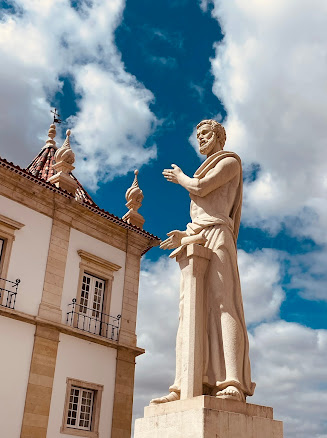
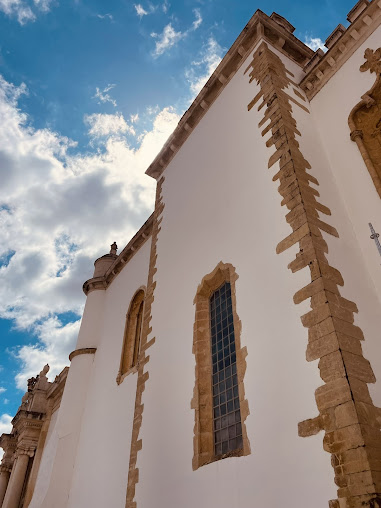
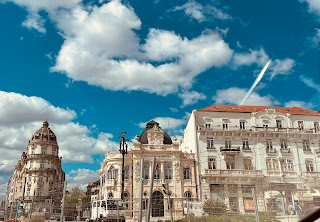
The first room of the library was an academic prison, used prior to the 1830s when the university governed itself. The second room was full of old books and nondescript. But that third room…the Noble Room. It was the most amazing manmade sight I’ve ever witnessed. Almost surreal. We weren’t allowed photography or video, which was really hard. You can find stock photos on Google, but believe me when i say, it does not begin to portray the feeling of walking into that space. Jim and i could have spent hours in there, climbing the ladders, perusing the 60,000 books (the best the world had to offer in the 15-1600s), and looking for the bats. But you can’t touch anything and they herd you out like cattle after only ten minutes.
The following three photos are stock photos from online to give you an idea how magnificent it was.
In the cities, the ancient structures stand alongside modern ones. And there is unfortunately colorful graffiti on a lot of it. Speaking of vibrant color on the walls, it is disturbing to me that after only four days, I fear I’m becoming a little immune to the beauty of the colorful tiles. How can I have such a short attention span?
Fifteen minutes outside of Porto we decided not to saddle ourselves further with a rental car when we can’t even drive in front of our hotel, (let alone park there). We looked up the locations of Eurocar and subsequently drove into what had to qualify as one of the sketchiest neighborhoods in Portugal!
Our GPS told us we had arrived but we saw nothing and were basically in a parking lot with a whole host of black and green taxis. We parked along the street to call the rental place and Jim pulled out his most used Portuguese phrase (after obrigado). “Do you speak English?” We were told the car rental entrance was underground. We’d circle back and find it. So the next task was to find a gas station as we needed to return the car with a full tank. Like everything else today, this was much easier said, than done. What a nightmare.

Twice the GPS took us to dud locations, the second being a service station where a car nearly backed up into us (it was literal inches) and the two old guys (with no English words) tried with equal parts determination and annoyance to give Jim directions to a gas station. I’m pretty sure the main guy was slapping us with some kind of derogatory label, because he said the same word several times (under his breath) with obvious exasperation. We drove around traffic circles and even over curbs in our attempts to reach the gas station to fill the tank for return. Nothing has been easy today!
Once at the gas station, we could not read the instructions and of course the ONE thing not covered by the extra insurance we “impulse-buy” purchased was putting the wrong gas in the tank….
A lovely lady assisted Jim (mostly because she was stuck behind us and probably had somewhere she needed to be…) we were back in business with 45 minutes to spare until the rental place closed.
Can I tell you how happy we were to give up the car and meet our friendly uber driver (who incidentally ALSO circled the area multiple times trying to find us)?
The traffic in these cities is insane. It’s impossible unless you’re on a motorbike (as many are). Those with two wheels just make up their own lanes, weaving around cars and completely avoiding the clog.
We had planned to drive 90 minutes out to a national park on Friday, but we were DONE. Stick-a-fork-in-us DONE. Jim (the adventurer of our balanced pair) said (AND I QUOTE) “I don’t care if I have to lie down in the hotel and read a book on Friday, I’m finished driving.”
Hallelujah.
We were delivered to our Porto hotel and it is positively lovely. It sits regally, all lit up at the bottom of a cobblestone hill on the corner along the river. There’s no street traffic in this old part of town. Had we removed our tight grips from our suitcase handles at the top of the hill where the uber left us, our bags would have raced down over the long block of cobblestones and flung themselves into the Douro River. (Probably permanently sinking to the depths with my Portuguese pottery purchases….) That was a lot of Ps in one sentence.
We had dinner by the water. Both being a little seafood-weary, Jim had steak and I went for the first vegetarian option I saw.
(This is our gorgeous hotel in the moonlight.)
The bridge and colorful lights reflecting in the water are just beautiful. I think we’ll both sleep soundly tonight, knowing we are not responsible for any driving or navigation for the rest of the week. We need to sleep fast because we meet a new tour guide early tomorrow.
Portugal: Day 6
Early this morning we spotted a seagull using the crosswalk by the PalacIo da Bolsa. (I TOLD you they were serious about their crosswalks here!)
There were seven delightful people on our small group tour for the Douro Valley. Two ladies from the UK, a couple from Southern California, a woman from Chicago, and us. Our guide for the day was Francisco. The middle C pronounced CH. We were picked up in a black Mercedes van and we scored the front double-seat, which was fortuitous because I dry-swallowed my Dramamine about four minutes before Francisco’s arrival.
When telling our new friend how much we disliked driving in the cities here, he answered, “We don’t drive, we survive.”
Douro Valley, or as Francisco says it, “Dervolley” is an extremely old region for winemaking. It’s an isolated area and difficult to navigate.
Ages ago, Celtic and Roman people lived peacefully there together. In the Douro Valley there is a second Portuguese language which is a combination of these two cultures.
In 711 the Moors came and lived in the mountains. The wars between the Moors and Christians began thereafter and lasted for a long time. They began marking land (and chapels, monasteries…)with their distinctive flags. A petty practice, but preferable to the territory-marking system used by male cats.
Portugal started shipping wine to the English when the English were at odds with the French. In those days bottling was not an exact science and it was not easy to transport the wine intact. It originally arrived too fermented (turned to vinegar) and finally when they figured out how to stop the fermentation, it became super sweet by the time it arrived. As a result, the English developed a taste for sweet wine and several English families moved to DV to learn how to make it.
Our local guide is also a teacher at the university. He is full of information and it is dispensed in quick and thickly-accented broken English. He was great. Some of my favorites included:
“Reglementated” for regulated
“You will have opportunity for to relax”
“We’ll turn around and you will see better the museum.”
“Still to enjoy…we leave soon.”
On our journey, we listened to Francisco’s music picks. Port Wine by Bill Samuels was playing as we drove toward the misty cloud-enveloped mountains in the distance. It was our first glimpse of the outer edges of the region and it was rather awe-inspiring.
Tucked inside the mountains, the DV has its own climate. Temp ranges between 47 and 114 degrees, though it hit 121 a couple of summers ago). Sometimes there is more than a 20 degree difference on the other side of the mountains. (Our guide at the first winery said DV has a “hellish climate” and global warming is making it more unpredictable.) Not good for calculating grape harvests.
They’ve added long (4 minute) tunnels to get in and out of the valley. The tunnel saves 3-4 hours of driving and took ten years to build. We spilled out of the tunnel into the brilliant sunshine of the Douro Valley at 9am.
In 1755, an earthquake, 8.9 strength, resulted in crumbling devastation, fire and then a tsunami hit. Thousands died. Parts of Spain and Africa were also laid to ruin. But Marques Pombal determined to try to reclaim the Douro Valley.
Some things I learned:
Vin verde is green wine. I was a little disappointed to learn it’s not actually the color green (as in salsa verde….) On arrival, 15th-16th century explorers found lots of new produce they weren’t used to. They struggled to figure out how to grow the plants they weren’t used to and grapes ended up not being mature enough. So the product of grapes that are not quite ready is called vin verde, and we were told it “tastes better than it used to.” (Not much of an endorsement.)
The port wine is very famous here. It was originally even used medicinally. We drank a lot of port. All three types. All over the place. And we’re still not big fans.
A staggering number: There are 30,000 wine producers the valley.
The Douro Valley boasts more than 250 kinds of grapes. Most wines in the DV are a blend of at least five grapes. The vineyards are built in terraces, horizontal, vertical, diagonal. Stones and slate are used for the walls of each layer of the terrace. Donkeys and horses are very important here and pretty much everything else was created and coaxed into being by hand. Very hard work. The workers still start around 5am and take a break around 8am with bread dipped in red wine. Despite the hard life, the spirit of the people is joyful. Dancing, singing, and happy. Especially in September at harvest time.
There are thousands of birds (including eagles and falcons), fox, wolves and wild boars in the valley.
First stop was called Regua and pronounced “Hegwa.” This little town lies between the first and second subdivision of the valley. Jim got some more pastel de nata (we think he’s at around fifteen now) and a macchiato. I bought some local honey candies from the region so I’m prepared for my next cough. We walked across the bridge over the river.
Back in the van, the road snaked along the river (which runs from Porto to Spain), passing one of six dams, romantic rustic buildings, and beautiful green layered vineyards on every hill. We drove by the vineyard where the Obamas vacation, and admired some almond trees dressed in white blossoms at the base of the hill.
Our first winery was Quinta do Tedo and it was gorgeous. 32 acres producing 60,000 bottles per year, mostly of port. The guide stood in the vat where they still use Portuguese feet to smash the grapes after only three days of fermentation. (That’s why port is sweet, instead of the 10-12 days of fermentation for regular wine.) By using feet instead of machinery, they avoid crushing the grape seeds. It’s a three hour shift of stomping and it takes maybe 21 hours to complete a vat.
Our guide told us to try a Porto Tonico: He makes it by starting with a white or rose port, a squeeze of lemon, tonic water and gin to taste, though there are variations. He says it is a perfect summertime drink. “Beautiful but dangerous”
Second stop was the village of Pinhao. We drove over a bridge made by the designer of the Eiffel Tower, saw some mud swallow nests, and stopped to get a closer look at a beautifully-tiled train station.
We lunched in that town, tasting so many interesting local foods. My favorites were the very smoky white meat sausages which tasted like someone just pulled them off a wood fire, the sautéed greens atop the ribs, and a refreshing fruit salad, which was needed to balance all the heavy potatoes, breads, wines, and sauces. The entire rest of our party ate a traditional port wine cake or flan. We sat across from a mother and her adult daughter. The daughter had the same voice, mannerisms and expressions as Emma Thompson and she lives a charmed life in Wales, her home in a cottage from the 1300s.

Took a solar-powered river cruise after lunch. So many wind mills and solar panels here. The Portuguese even get power from the ocean waves. We saw countless vineyards and wineries from our breezy touring boat. Some had vineyard records dating back to the 1200s. Vineyards in DV are planted with rows of grapes and intentionally with many olive trees to help with irrigation. (I’ve sure eaten more than my share of olives since arrival.) The slate here helps to retain water, as well.
Our guide drove us quickly through an old Roman neighborhood, still enclosed with its original short walls (Francisco called it Roman terrace). There were even some ancient Roman steps, which Jim captured for me, since my phone was already dead from too many photos and too many words. (A travesty!) Those stone steps protruding from the wall were hand-constructed roughly 2000 years ago. Incredible to think about.
The unique switchback Roman road which felt like a wild rollercoaster was zigzagging up the side of the mountain and was NOT a one-way street. But you would never suspect that was possible based on the white-knuckled speed at which our (not small) Mercedes minivan flew over the stones and around the blind corners. 
We passed cork trees, a fortunate pairing alongside the grapevines. It takes 7-10 years for the skin of the cork tree to regenerate for the next peeling. Despite this abuse (or maybe BECAUSE it makes them resilient) these trees can live about 200 years. SO many things are made from cork here, including an entire house, which we passed on the way to our second winery for tasting.
The roads atop the Douro Valley were positively breathtaking. The road skirted the edge of the mountaintop in serpentine fashion, the turns heart-stopping at the highest points of the cliff. Sometimes the guardrails were missing, which actually made me gasp as we came around one sharp bend on the tiny road. We were at a dizzying height, the terraced fields and olive groves were beneath us, spread over the mountains like an intricate patchwork quilt. The artistry of the vista was evident, a land groomed to perfection by generations of hardworking hands.
We tasted award-winning wines at Quinta do Beijo and bought a few of our favorites which they will kindly ship to our house for a price that pared my husband’s wish list from six to three bottles. 
There were 18 people in our tasting group, and if we’re counting our excellent local guide, the 18 of us were from 8 different countries.
The highlight for me was crawling inside a used wine aging barrel, which had sat empty for three months. It was stained, rugged, sweet-smelling, and felt absolutely amazing. The only person more surprised than Jim to see me enter that itty-bitty hole in the barrel was ME. Carpe Diem, right? Getting out was harder than one might imagine. Jim has video evidence.
Passed a park full of plantain trees. The “Parque” was named after BB King, who fell in love with the town of Sabrosa. (Sabrosa was incidentally Magellan’s hometown, too, and his statue stands proudly overlooking all the shades of green.)
Ominous clouds started rolling in when we were on the boat, but luckily the first drops didn’t fall until we were in the van driving to Porto around 4:30. By the time we got back to our hotel an hour later, the sky had brightened again.
I just learned that there are two speed limits on highway signs in Portugal. The number at the top is maximum speed and the number below is minimum speed. Fines are equal for both infractions. The highway we were on for most of the drive back to Porto was 120 and 50. Our driver and guide easily drove ten over maximum.
In the rain.
While providing excellent playlists for every portion of our long day.
And while intermittently popping on his headset and plugging in connections to give us useful information.
Some people are better at multitasking than others. An example. I once sneezed while driving and my Jeep Cherokee, did a 180 degree spin, barely missed a telephone pole, and thought I might pass out when I exited my car to the sound of hissing tires.
(This is just one reason I’m not a tour guide or an uber driver….)
There are orange and lemon trees growing everywhere. Because we’ve been eating continuously, we have done very little damage to the extremely large bag of oranges we bought from the roadside truck outside of Evora. We are beginning to wonder what to do with them. Leave them for the hotel cleaning service? Donate them to the hotel kitchen for their morning fresh squeezed juice selection? I have a feeling giving away oranges in Portugal in April is like putting fat zucchinis on people’s porches and in people’s car seats on a Sunday morning at home in August.
Chilly evening. We wandered the Porto streets searching for restaurant menus which listed something other than the recurring cod fish, mussels and octopus.  I just CANNOT. Found a place called Tapas 65 and when we spied chicken in a puff pastry and Caprese salad, I was ALL IN! It did not disappoint. And not just because the diners at several tables around ours ordered some sort of sausage dish that was lit on fire, the lingering flames from which appeared capable of roasting marshmallows.
I just CANNOT. Found a place called Tapas 65 and when we spied chicken in a puff pastry and Caprese salad, I was ALL IN! It did not disappoint. And not just because the diners at several tables around ours ordered some sort of sausage dish that was lit on fire, the lingering flames from which appeared capable of roasting marshmallows.
Portugal: Day 7
We are are pressing agonizingly near to our date with the airport. Clues include Jim’s morning announcement during our extravagant breakfast smorgasbord, “I’m starting to get a little sad,” and my complete surrender from trying to speak Portuguese phrases to people. I am now resorting lazily to my standard “good mornings” and “thank yous.”
News flash! Smoked Bacalhau was on offer at breakfast today. Oh joy. Oh bliss. It’s like Bill Murray’s Groundhog Day with the codfish.
We walked along the river, noting the squawking gulls, the hopeful pigeons, and the seemingly tireless buskers and musicians who are out in force from the break of dawn until way past the time people should be sleeping. Restauranteurs endure a continual cycle of setting up outdoor tables and tearing them down. When we prop our screen-less hotel window open, the sounds from the streets below always include some form of music and often the cries of birds, the rumble of a rolling cart on the cobblestone, and several languages being spoken.
My phone map said it would be a 22 minute walk from our hotel to the meeting spot on Rua de Alexandre Herculano to meet our morning driver. It mentioned something about a 300 foot climb, but I foolishly paid it no mind.
The staircase, which was tucked into the centuries-old architecture was remarkably deceiving. Each time we walked to the point of exhaustion, the staircase would turn 45 degrees, uncovering the next section of leg torture. When we finally made it to the top of those freaking stairs, my heart was hammering, my breath was short, and I felt like I should have been in line for a ribboned medal or other well-earned reward. Perhaps a t-shirt announcing: I survived Escados dos Guindais!
There’s no way I could have climbed those steps one year (and an extra 25 pounds) ago. But, my usual home carbohydrate consumption has at least quadrupled over these last six days. It’s back to cottage cheese, greens and protein when I step off the plane.
Young Matheus (Matthew) from Brazil was our private tuktuk tour driver for the morning. He was chatty and sweet, driving us over the cobblestones and squeezing into places he wasn’t supposed to be in order to show us the city. For almost two hours we were rattled, jiggled and jostled in the back of the little white electric vehicle.
We were all over Porto, from riverside to upper levels of the city where abandoned buildings were covered in graffiti, views were spectacular, and a hardworking musician provided the soundtrack. (My sincere apologies if the colorful graffiti I chose to pose next to in the photo is nothing but strings of Portuguese profanity….)
Our guide showed us an old fire box with a ring system. Embossed right into the weathered metal box was the key for how many rings of the bell were used for each different area so the firemen would go to the right location to fight the flames. Matthew even drove us through a traffic tunnel to get one last view of the river. I’ve honestly never imagined I’d be riding in the back of a tiny open-air tuktuk without my seatbelt fastened, through a tunnel teeming with regular traffic. It was a bit unnerving.
Between the cobblestones, the speed of our souped-up go-cart, the river breezes, and the clear plastic weather tarp on the roof, it was no small feat to take photos from the vantage point of our seats. Apparently, these machines only need an overnight plug-in. (This means they endure longer than my phone charge has for any of these traveling days in Portugal….)
After our tour, we walked through the Bolhao Market in the center of Porto. Dried and tinned sea creatures, mushrooms, cheeses, plants, cut flowers, meats, and fresh produce were the main wares. The most off-putting offering (save octopus) I noticed was the paper cones of spiced cod chips. Just WHY? Paper cones are meant for things like cotton candy.


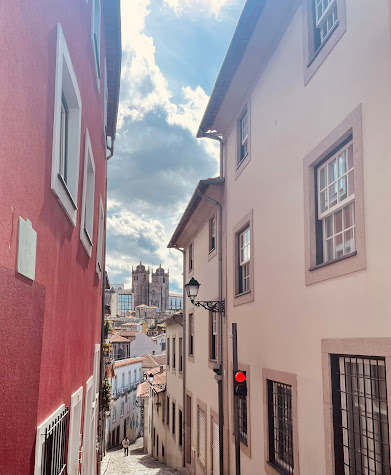






I considered bringing back chocolate sardines for all the short people in my life, but I don’t want to try to keep chocolates from melting during our travel day. Besides, the “seating” in my carry-on luggage has already been spoken for by the queuing lineup of fragile Portuguese things I have managed to acquire. In 1837, the city council decided to build a market on some land donated by the Church. Since that time it has been the city’s favorite spot for fresh produce. It was recently renovated, and I found it to be refreshingly clean and tidy. In fact, the public restroom at the market was the nicest I’ve encountered anywhere in Portugal, boasting both hot water for handwashing AND a seat affixed to the toilet! (Let me tell you…I’ve been practicing my yoga chair pose regularly and my muscles are getting unplanned workouts.)
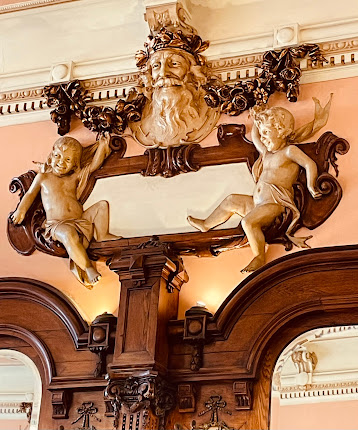
We had lunch at The Majestic Cafe, an elegant spot which is said to be one of the most historic cafés in the world. Since the early 1920s, it has allegedly been a meeting place for artists, intellectuals, and celebrities. The interior design is Art Nouveau with leather furniture. There are impressive Flemish mirrors and an ornately decorated ceiling. The food was a little overpriced, but the cafe was filled to the brim with people (who like us), were paying for lunch and a wonderful memory, too. This fun spot on the bustling shopping street of Rua Santa Catarina was yesterday’s recommendation from our travel agent, Karen. (Call her to round out the edges of your itinerary and travel details if you’re going somewhere. She’s awesome!)
I had the tuna, but Jim tried a local favorite which our driver, Matthew told us about. It’s a sandwich called the Francesinha. It includes steak, spiced sausage, ham, and cheese. (The entire butcher shop!) The whole thing is doused in a “special sauce” which resembles a thin gravy, then served with a knife and fork.
It will not surprise you that Jim was toting a bakery box stuffed with two more fresh pastels de nata to enjoy after his “light” lunch.  The man knows what he likes.
The man knows what he likes.
Came upon an amazing church, the tiles of which just melded into the clouds behind it. I was captivated. It was built in 1739. This is me on the steps of the Santo Ildefonso.
We shopped a little and then located the street to connect us from the city of Porto to Vila Nova de Gaia on the upper level of the impressive Don Luis Bridge. Jim has been admiring its height and expanse since our arrival.
I found it more than a little unsettling to be walking along so very far above the river while long and HEAVY yellow trains rumbled by right alongside me, shaking the bridge upon which I stood. Seeing straight down through the cracks underneath my feet did nothing to bolster my confidence, either.
Once safely in Gaia, we hiked up the long incline to get a closer look at the outside of the Mosteiro da Serra do Pilar. This 16th Century monastery sits right on the upper level Gaia-side of the bridge. It’s a massive circular building, looking down over the river and over the booming hub of the port wine industry below.
In order to get back down from the top level of the bridge to a more reasonable height on the riverfront, we bought two one-way tickets to the Teleferico de Gaia. This is a fancy enclosed cable car which gave us a 5-minute bird’s-eye perspective of both Porto and Gaia. Despite our large round gondola hanging onto the cable with only a meager pin, it somehow felt safer than standing on the bridge.
We have seen our beautiful hotel from SO many different angles since our arrival. Its yellow color makes it easy to spot. The residences surrounding the historic main structures along the river are classic for this area. Narrow colorful properties with small iron-clad balconies, many with aged azulejos tiles. I never tire of peeking up and down the tiny streets in this vibrant place.
Many of our guides and drivers have spoken with us about the poor wages in this country. They are losing the next generation to other places where there are more opportunities. So many of the people we’ve met sadly have family members across the globe they no longer see. Some for more than a decade. Sometimes it’s the other way around. Our tall young driver who rescued us from the rental car debacle was from Kashmir. His family is still over there (now in Pakistan) but his brother has joined him and they bought themselves a reasonably-priced property in the lovely Duoro Valley. A solid hour from his Uber gig.
We shopped some more, a regrettable pastime which will force some serious packing skills, come Saturday morning.
We have been crazy fortunate with the weather. When we were watching ten day forecasts from home in anticipation of this trip, it looked like we would have rain here for most of our trip. But the weather has been absolutely gorgeous. The rain began to fall on us tonight at 7:15 when we stepped outside to walk to dinner. Good thing we got to use that umbrella! It’s got a bent wire and I may leave it here to offload some weight on the airport scale.
We tried to avoid getting drenched on our walk to Terreirinho for dinner. The place was warm and inviting, its old stone walls welcomed us in. The hostess settled us at one of the only remaining tables upstairs. A cozy nook diagonally across the landing from an Irish group of four, the loudest of whom sounded exactly like the bossy blonde ringleader on the hilariously irreverent Netflix series, Derry Girls.
All the restaurants were packed tonight since the scenic spots at the outdoor tables are cold and soggy. We had an adorably eager-to-please waiter named Fernando. He had the build of a sedentary middle school geometry teacher and the voice of Kermit the Frog. He started this job just ten days ago and spent his whole evening running up and down the stairs with plates. Fernando is going to get fit. Unless he tastes the lemon pie. Even my lemon-particular husband approved.
Portugal: Day 8
Our final day before traveling home. I will admit, I’m weary of living out of a suitcase.
As I sat by the window this morning waiting to order my omelette, I watched the rain outside falling gently on the stones and appreciated the methodical motions of the shopkeeper at the Casa Lopez across the Rua. He was optimistically opening the protective umbrella over the single client table in front of his property. Seating for six. He repeatedly glanced up at the weather, searching the thin patch of sky between the buildings, as though hope would change the direction of the persistent clouds.
After the luxury of spending a solid week as an observer of new people and new things, I can honestly say my predominant emotion this morning is gratitude. I’m grateful for this life I get to live.
In the breakfast room this morning I opted against the slices of quince jam and the sheep cheese served direct from its bloomy white rind. But without much effort, I rationalized my favorite, the compata de morango (an incredible strawberry jam) by telling myself I’d balance it with a whole grain croissant. Also…the irony of choosing perfect orange slices from the breakfast spread to accompany my morning fresh pineapple stack (when we still have about ten in our room and one day left to eat them) is not lost on me.
Took an uber back up to the top of Porto after breakfast and visited the beautifully-tiled train station. A work of art.
Jim purchased a small coffee and his first chocolate pasta de nata in a bake shop from the cutest elderly lady. I chose a fresh slice of a Portuguese bread that tempted me from the window display on the street. It was chock full of candied fruit, nuts, and dusted generously with powdered sugar. There was a perfect candied sliver of citrus peel resting across the top and soon I too was dusted with powdered sugar, my brown sweater speckled as I savored that marvelous treat. Strolling up Praca de Guilherme Gomes Fernandes with that slice of heaven in hand is a memory I will cherish.
We came upon a lovely fountain by the university and just across the street was a blue-tiled church. It was Igrejo do Carmo, built in 1736. The outdoor tiles were covered with a fine netting because the modern metro tends to vibrate the tiles loose and causes too much damage.
We bought tickets to go inside, following the tour signs through the church, up into the top floor next to the pipe organ, through the religious displays and finally outside to climb to the rooftop.

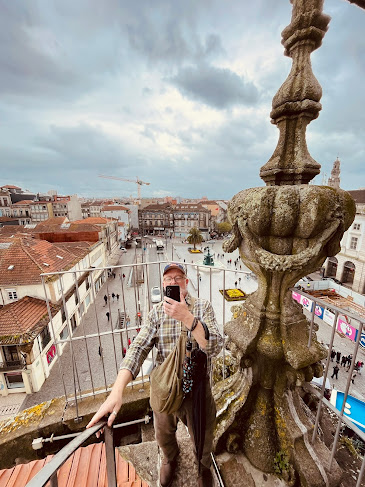
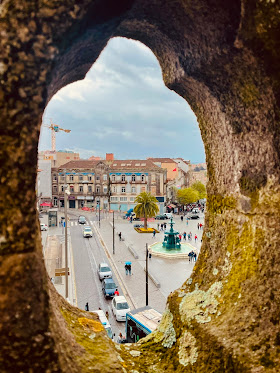
The catacombs were a little creepy with many devotees buried there. There was one glass-encased open wooden casket displaying the mummified remains of a poor fellow in purple robes. He was a very small man and I didn’t care for the look of his petrified teeth. When we first entered the lower floor, we were standing on an area with a see-through construction material and were able to look down upon the remains of the dearly departed beneath our feet. I’m not sure I’d want people observing (and traipsing over) my aged useless spine in 200 years, but maybe the deceased faithful are less concerned. 383 brothers were buried in the catacombs of the church within about only 20 years in the mid-1800s. I checked my history and it looks like that was right around the time of the third and fourth cholera outbreaks.
Ahhh, pandemics. What goes around, comes around….
Jim climbed the tower of Torre dos Clerigos while I stood at the base with my umbrella taking photos and listening to the captivating bells and the musical chimes which were enchanting the listeners in the square.
I had my own tower to deal with. Since I had time to kill, I conveniently bought myself a beautiful hot chocolate in a cafe. My personal tower was one of whipped cream and liquid chocolate.
Jim’s tower adventure involved a 75.6 meter climb to the top of Torres Dos Clerigos. In utter opposition to everything I’ve learned about my life partner over these last 46 years, he threw me a curve ball and purchased the touristy photos of himself at the top of the tower because he knew I’d love it. He presented the QR code of himself to me like a carefully chosen gift. Which it WAS.
Jim rewarded himself with his most delicious gelato of the trip, chocolate and dulce de leche which he enjoyed while I sipped my decadent hot chocolate. (It was so thick and rich I actually couldn’t finish it.)
There is an old olive grove at the base of the tower where I got up close and personal with the trees in spite of the drizzle. I really wanted to make a souvenir for myself with a leafy olive twig, but didn’t want to get arrested. Our track record with the local authorities is already in question.
Walked to the main square by City Hall and went into a couple of shops. The sun appeared yet again, making us feel like somebody is looking out for us.
We took the Escados Dos Guindais DOWN this time (much easier) and it was 290 steps to the bottom of that 300 feet.
Hit the riverfront by 2:15. We stopped at a little restaurant where the proprietor spoke zero English but still understood our request to sit outside, share a bottle of vinho verde, and order a margharita pizza. This was my favorite wine this week. He brought us two pastel de nato too, even before the pizza arrived. Clearly he pegged Jim immediately. A more serious rain began to fall just as we drained our bottle of wine, but our hotel was just down the street.
We recharged and were right back at it to squeeze the last minutes out of our time in Portugal. We set out with a large hotel umbrella and passed by an upscale McDonalds on the way.
We toured the Igreja de Sao Francisco church and catacombs on the street below the Bolsa Palace. WOW. Just wow. We walked inside and actually had to sit down. It was SO much to take in at once. I couldn’t decide where to look. I have never seen so much gold leaf and gold paint in one place. Everything was so ornate. Angels, apostles, saints and images of Jesus and his mother were just everywhere, each of them more bedazzled than the last. Jim noticed the extreme use of curlicues and he was not wrong.


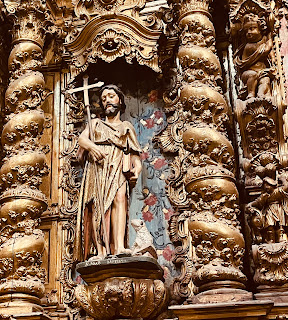


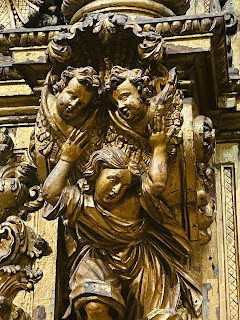

The catacombs of this church were much more orderly than the smaller church we visited earlier today, though the number of deaths during those same choleric years was remarkable. Many were entombed in the stone walls but everywhere we walked, there were numbered wooden doors beneath our feet. The doors making up the entire floor did not feel well-secured, so I imagine someone needs easy access to the basement of bodies. The ceramic skulls decorating the top edges of the burial area felt morbid and redundant. An unnecessary reminder of the dust we are.
Spent most of my last Euros on lightweight gifts at the River Market and then headed back to our room for the bittersweet task of packing our suitcases for the return flight tomorrow.
We’ve got a reservation at Ode Porto at 7:30 this evening for our last dance with Portuguese seafood. It will be the fanciest and priciest restaurant of the week for our final night. You can’t just walk into Ode Porto. You need a reservation and have to tap the door knocker twice against the old wooden door. This place is religiously serious about their wines.
The culture of tipping and the way the bill gets paid feels very different in Portugal. The waiters will let you sit indefinitely because they don’t want to rush anyone. Sitting at the table for the whole evening is as important as the food here. You almost have to beg for the bill. We tried (admittedly without a lot of success) to be patient.
We are hoping for a smooth flight home and trusting Irene the cat wasn’t so spoiled by Adriana’s attentions, she changed the locks.
It was a beautiful trip. I will miss the escape from reality. I will miss the Portuguese pavement. I will miss the adventure.
But I will not miss the codfish.



































































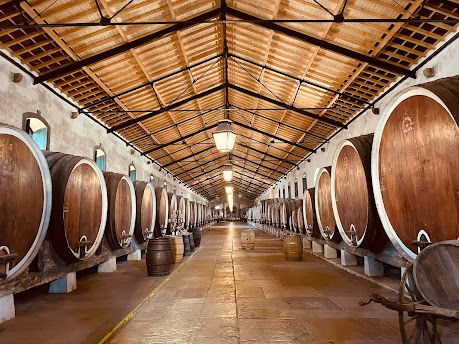


 Several miles of narrow winding roads followed our visit to the beach with the green pool. Our guide, Sara drove us through Azoia and to Cabo de Roca. Have I mentioned, everyone here drives too fast? It’s like a racetrack for serpentine-loving daredevils. I was thanking heaven for Dramamine and sea bands.
Several miles of narrow winding roads followed our visit to the beach with the green pool. Our guide, Sara drove us through Azoia and to Cabo de Roca. Have I mentioned, everyone here drives too fast? It’s like a racetrack for serpentine-loving daredevils. I was thanking heaven for Dramamine and sea bands. 












































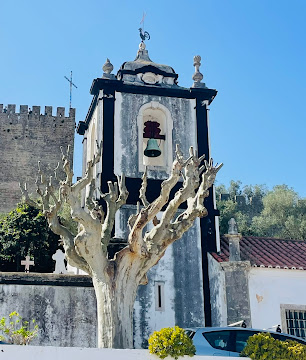



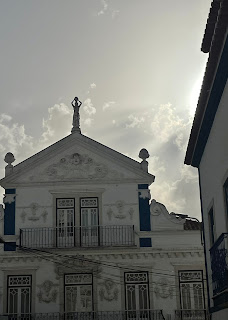


















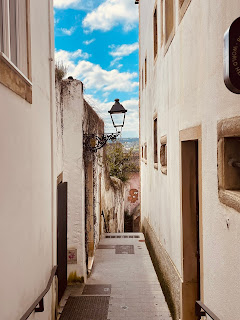













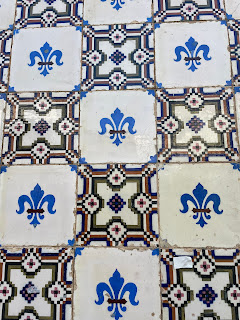

























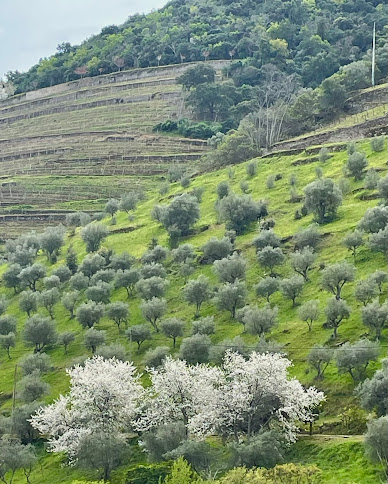
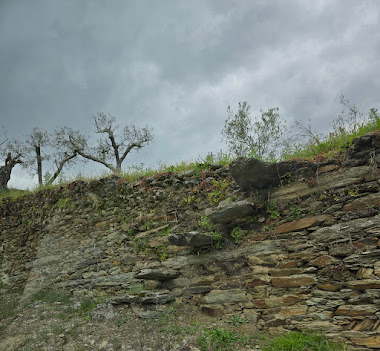
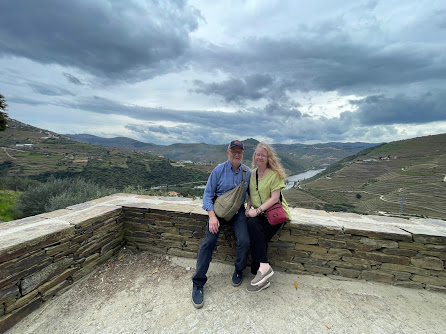








 I just CANNOT. Found a place called Tapas 65 and when we spied chicken in a puff pastry and Caprese salad, I was ALL IN! It did not disappoint. And not just because the diners at several tables around ours ordered some sort of sausage dish that was lit on fire, the lingering flames from which appeared capable of roasting marshmallows.
I just CANNOT. Found a place called Tapas 65 and when we spied chicken in a puff pastry and Caprese salad, I was ALL IN! It did not disappoint. And not just because the diners at several tables around ours ordered some sort of sausage dish that was lit on fire, the lingering flames from which appeared capable of roasting marshmallows.



